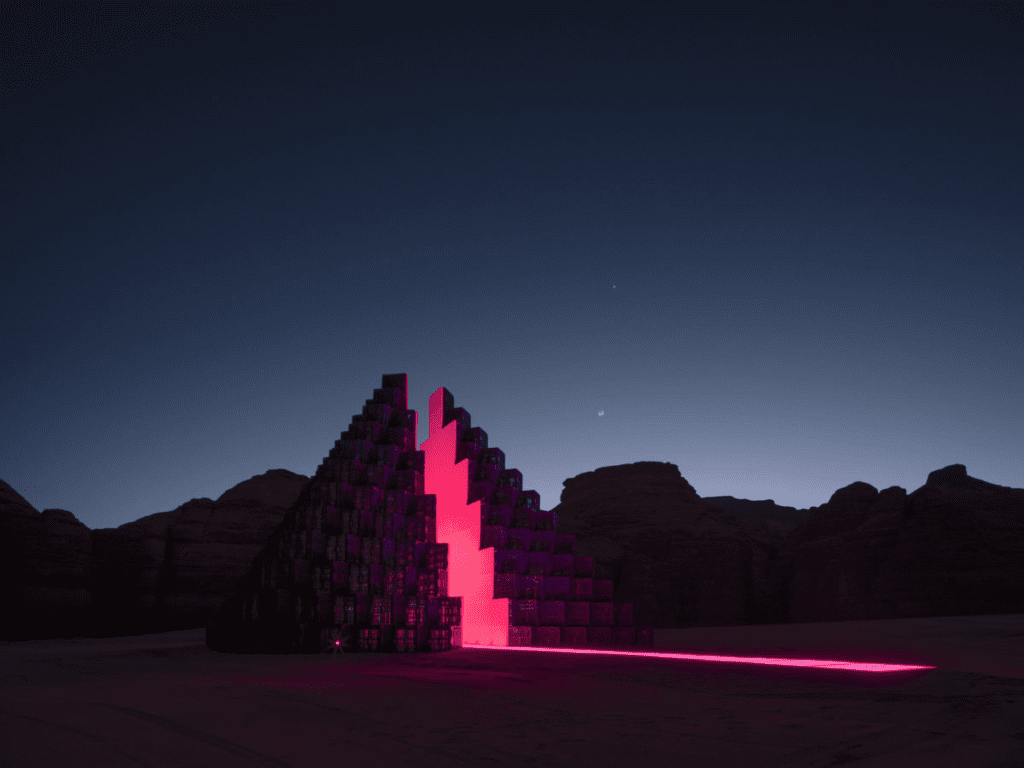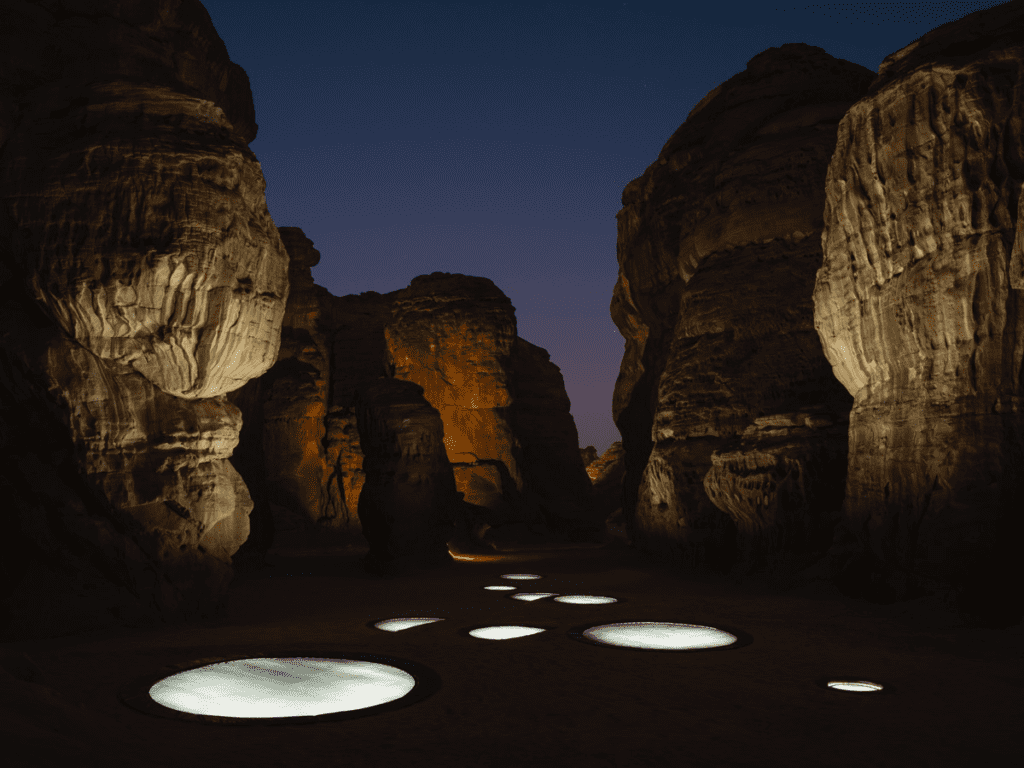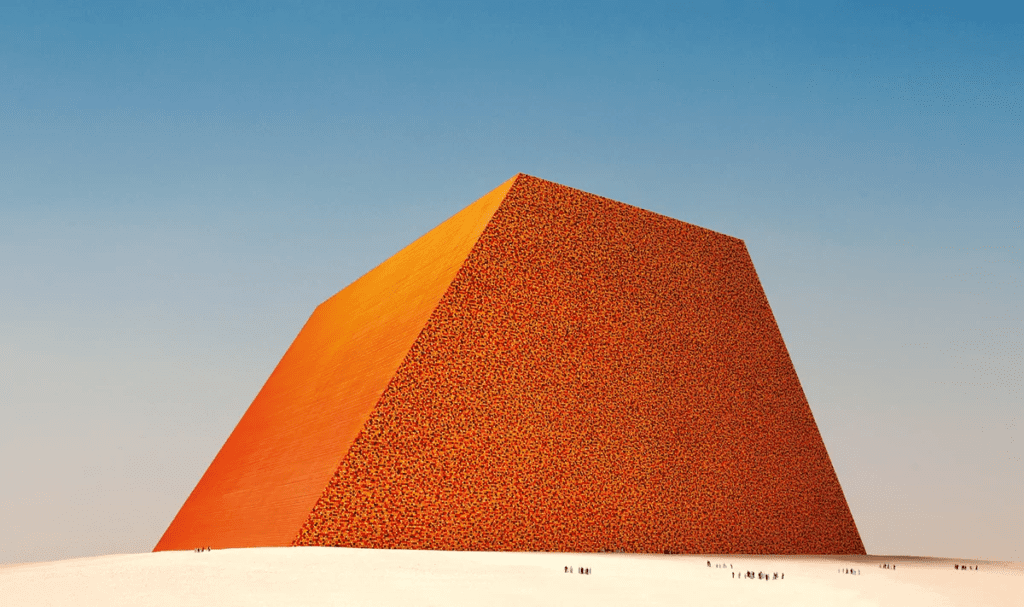An ongoing collection of works of Desert Media Art around the Arabian Gulf.
A Concise Passage by Rashed Alshashai

In the small desert town of Al Ula in Saudi Arabia, a large ziggurat made from blue plastic crates stands at a height of 15 meters in the middle of a sandy valley. Dramatic and playful yet with a deeply resonant message, the work, by Saudi Arabian artist Rashed Al Shashai, and others on display reference the travel and cultural exchange that once occurred here—and perhaps can be reignited through artworks and discourse.
Al Shashai’s artwork, titled A Concise Package, speaks about the town’s history as a stop on the incense trade route that wound through the region, sheltering travelers from the harsh desert climate in the mountains. This work is part of the inaugural Desert X Al Ula, an art exhibition that, despite some controversy over its connection with the Saudi government, is proposing new ways of making and displaying art in the region.
Now You See Me, Now You Don’t by Manal AlDowayan

https://www.manaldowayan.com/now-you-see-me-now-you-dont.html
Now You See Me, Now You Don’t, are the words that a humble puddle in the desert of Saudi Arabia would say to any of her curious visitors. The puddle is only ever here for a brief moment, formed as if by accident. This will never be its permanent home. The encounter with the unexpected puddle can suggest and carry a tremendous amount of information. It also instigates a range of ideas, thoughts that can disappear at any given a moment.
In urban spaces, puddles have a particular reputation; the puddle is not an innocent natural phenomenon. In cities, puddles are usually seen as the sign of an imperfection of design, or a failure in engineering. They are to be eradicated and avoided in most spaces inhabited by humans.
Here, AlDowayan presents a set of puddle-like installations designed to last for a few months; they do not belong to this landscape, and yet they appear, paused, contained, existing in the crevices of the AlUla rocks. The puddles are not real, but are made of massive trampolines that can be touched, laid upon, jumped on, and observed. In the evening, they become moon circles, activated through a series of lighting techniques as people interact with them. As encounters with the work becomes bodily, a physical exchange of cause and effect, awareness of the environment, its sensitivities, receptiveness, and actions are heightened.
Dictums: Manqia II by Wael Shawky

https://desertx.org/dx/desert-x-alula/wael-shawky
The mountainous landscape in AlUla forms a backdrop for Shawky’s video work that is derived from Dictums: Manqia I – the film is inverted, rendered in negative and re-oriented in portrait mode. The artist produced the film in negative to further highlight themes of memory, history, and nomadism. Shawky’s mud house is also inverted with a Bedouin-style tent on top of its roof rather than the ground. Together, the house, tent, and film projection create a distinctive and surreal landscape.
Media Art in UAE
Lunar Reflection Transmission Technique by Taro Shinoda and Uriel Barthélémi

Sharjah Art Foundation description:
“In Lunar Reflection Transmission Technique, Taro Shinoda expands his exploration of science, nature and existence, which have been standing preoccupations of his art practice. Using a telescope that he has constructed primarily from scrap corrugated cardboard and connected to a video camera, he has recorded the moon from different places, including Tokyo, Istanbul, Limerick and Boston, among other cities. Here, simple technology enhances our perception of interconnectedness with the cosmos, and subsequently, with one another. He explains: ‘I look at the moon and, a few hours later, you look at it in some different country. Observing the way the moon travels allows me to make an image of the whole world.’
For this new presentation of the work commissioned by Sharjah Art Foundation, Shinoda collaborates with the musician Uriel Barthélémi. Recordings of the moon are projected on a 9 x 12 metre screen amidst the sand and sky of Sharjah’s Mleiha desert and accompanied by Barthélémi on the drums. The percussive composition makes palpable the syncopation of lights, rhythms and colours that Shinoda has transmitted from different cities around the world, which now reverberate as sound across the desert.”
Holo Lumina: Sahara movements by Hybrid Xperience

In a project set in an area known as Dubai’s “Sahara” desert, Hybrid Xperience worked with three leading artists and two sound designers to create a mesmerising show as part of a Holo Lumina: Sahara movements” art project.
“The most challenging aspect of this project was bringing electricity to one of the most remote places on earth – the desert. We had to buy rechargeable batteries for each Hypervsn device as well as a backup because they wouldn’t last more than 30-45 minutes in one go. Next time we have already decided to get a proper generator that we can link all the holographic devices to and make such projects less hectic and time-consuming.” — Roy Azzi, an event producer with Hybrid Xperience
The Mastaba of Abu Dhabi (Project for United Arab Emirates) by Christo and Jeanne-Claude

https://christojeanneclaude.net/artworks/the-mastaba/
A brightly-coloured ziggurat made from 410,000 250-litre steel barrels, Christo has designed The Mastaba to measure 150 metres high, 225 metres deep and 300 metres wide, creating an edifice that would dwarf even the largest of Egypt’s ancient pyramids after which it is named.
The Seed in Abu Dhabi

It shows the evolution of a seed through various stages of its lifespan using light and sound and is nestled in a new beach area at the beautiful mangrove forest.
Desert Improvisation Experiments by Aaron Sherwood and Kiori Kawai

https://vimeo.com/518081722
https://aaron-sherwood.com/blog/
This is a series of improvisation experiments done by Aaron Sherwood and Kiori Kawai. They were in the UAE desert for 5 days to improvise in respective artistic mediums. The improvisation includes projection on dunes, live coding sounds and visuals, and dancing in the dunes and projections.
“We brought a deep cycle boat battery and an inverter to run power for the projector and sound equipment. All sounds are generated in real-time with my bansuri flute going through the live coding sound environment Tidalcycles. On the 2nd day we scouted some areas we could potentially project down onto a dune from above. This seemed like a good strategy to get a more even projection. We also prepared more for all the sand by doing some plastic wrapping” — Aaron Sherwood